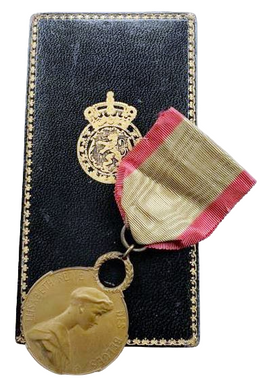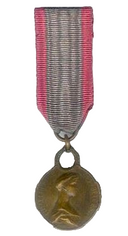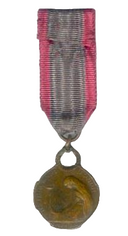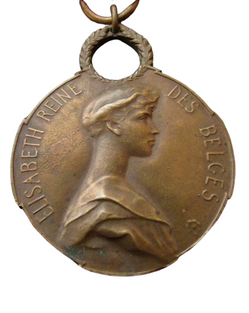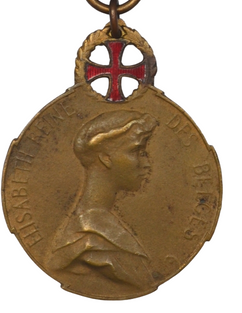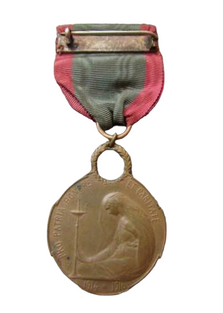THE ESTABLISHMENT OF THE REINE ELISABETH MEDAL
Design by Victor Rousseau | Institution 15 September 1915 | Royal Degree October 1916 | Engraver Alphonse Michaux
Because almost all nurses in the Hospital L'ocean at La Panne were British nurses enlisted in the V.A.D., Queen Elisabeth hoped their services would be recognised in due course. After the British General Headquarters suggested and supported the matter, it was turned down by the British government. Queen Elisabeth then took measures into her own hands and established a Belgian award.
The Queen asked Major Gordon to contact the Belgian sculptor Victor Rousseau when he was next in London. In February 1916, Victor Rousseau came to Major Gordon's house and, after he received the Queen's directions, made several sketches for the new medal. These sketches had to be altered twice before the Queen approved the final design. Major Gordon was then tasked with the choice of various ribbands. He bought some colours in London that he thought would please the Queen, and she finally went with a dove-coloured grey ribbon with a cerise edge on both sides.
The 'Reine Elisabeth' medal was instituted on the 15th of September 1915 and finalised on the 14th of May 1919. The awardee had to distinguish himself in aiding Belgian civilians or military personnel during the war, particularly in helping the sick and wounded for at least one year previous to 10th September 1919. The front of the medal has Queen Elisabeth's head in profile with the text "ELISABETH REINE DES BELGES" all around. The back of the medal shows a sitting female holding an oil torch. Beneath the dates 1914-1916 or 1914-1918 are please beneath together the Latin text "PRO PATRIA HONORE ET CARITATE" all around.
The medal measures 36 mm (1.4 in) in diameter and is struck in bronze (We also find examples in silver and gilt silver finishes). The ribbon has 38 mm (1.5 in) wide silk moiré and 6 mm (0.24 in) broad pink edge stripes. The suspension has a laurel wreath. Persons who worked in hospitals added a red enamel cross to this laurel wreath.
Thirty-three New Zealand women are known to have received this medal during the First World War—twenty-five of them were from Dunedin.
Important medals in museum's and collections
Nelson Provincial Museum - New Zealand
Mariette Victorina van Aerde, aka the Angel of Antwerp, evacuated injured British soldiers during the Siege of Antwerp in October 1914, became captured, and escaped across Belgium to Calais. After the war, she moved to New Zealand and settled first in Christchurch and later in Motueka, where she was buried in the RSA section of the Motueka Cemetery. Her medals (including the Croix de Guerre and the Knight of the Order of Leopold II with silver palms.) are kept at the Nelson Provincial Museum.
Do you want to learn more about her? Click Here
Imperial War Museum - United Kingdom
The medals of Mairi Chisholm and Elsie Knocker are kept at the Imperial War Museum. Mairi and Elsie are the most famous British frontline nurses on the Western Front. They entrusted Major Gordon with their journals for publication in London.
Musées des Beaux-Arts de Belgique - Belgium
The miniature medal of Jean-Pierre Vanden Eeckhoudt (Belgian painter) is kept in the Victor Rousseau collection of the Musées des Beaux-Arts de Belgique (Brussels).
Harris Museum - Preston - United Kingdom
The five members of the Belgian Relief Committee in Preston, Lancashire: Mrs Jamieson, Mrs Firth, Mrs Fitzherbert-Brockholes, Mrs Hayhurst and the Reverend Mother Superior of St Joseph's Orphanage and Hospital were awarded the medal. The medal awarded to Mrs Hayhurst is now in the collection of the Harris Museum.
North Carolina Museum - United States
The medals of Madelon Battle Hancock, an American socialite and a nurse who cared for the wounded during the Siege of Antwerp, are kept by the North Carolina Museum. After the Siege of Antwerp, she remained a nurse throughout the war in Flanders and married a British officer. She is buried at the Cemetier du Jas in Cannes and one of eight people commemorated in the NC Milvets Hall of Firsts on June 4th 2022
The medal display of Madelon Battle Hancock property of the North Carolina Museum.
Penryn - near Falmouth - Cornwall
Nurse Violetta Thurston, MM
In September 1914, at age 35, the St John Ambulance brigade invited her to lead a party of nurses to Brussels, where they would work with the Belgian Red Cross. She was one of three who accepted an appeal from the Burgomaster of Charleroi to help the French and German wounded. After the fall of Brussels, she was escorted out onto trains which took her to Hamburg in Germany. After being released in Denmark, the nurses of Copenhagen welcomed her; here, she read of illness and hardship in what was called “ the Belgium of Russia” (Poland). For her aid to Russian soldiers, she was awarded.
Royal Cross of St. George, For Bravery", 4th class presented by the Tsar of Russia.
On 4 November 1916, she was at the front again as matron of the Red Cross L'Hopital de l'Ocean at La Panne, in Belgium, where she stayed until July 1917.
From here, she transferred to the 15th Corps Main Dressing Station at Rouen. One night under darkness, a German plane dropped a bomb on the farmhouse, killing a Priest and wounding an orderly. While being evacuated, the aircraft dropped another bomb, bringing down the entire structure. Miss Thurston was
knocked down by the falling roof but recovered enough to help the stretcher-
bearers carrying wounded away, over fields of sugar beet, in pouring rain, to the
next line ambulance. For this action, she was awarded the Military Medal. After the war, she was involved in many more medical activities, and she died on
13 April 1978, at Penryn, near Falmouth in Cornwall, all her military medals were buried with her. Do you want to learn more? Click Here
Toitu Otago Settlers Museum - New Zealand
The medal of Mary Seward Blackman is on display in the Toitu Otago Settlers Museum. Her grave is one of 16 holding a plaque erected in 1917by the Belgian ambassador in New Zealand depicting the Queen Elisabeth Medal.
Family collection
Edith Elizabeth Appleton O.B.E. R.R.C.
The medals of Edith Elizabeth Appleton are kept in the family of her descendants. Edie arrived in Ostend on Sunday 10 October 1914 but soon found herself at Boulogne. She served at No 10 Stationary Hospital at St Omer. Where she must have witnessed the death of Lord Roberts. Later on in 1915, she served at No 3 CCS (Casualty Clearing Station) and In November 1915 she transferred to No. 1 General Hospital at Étretat. Wanna learn more about her service? Click Here
The Green Howards Museum - United Kingdom
The medals of Mary Devas Marshall are on display in The Green Howards Museum. She was one of the few women (like Elsie Knocker and Mairi Chisholm) decorated with the British Military Medal. She earned the Military Medal while she was based at the hospital at Marquise on the grounds of the 1st Aeroplane Supply Depot She originally enlisted in the First Aid Nursing Yeomanry (FANY) in 1912 and was first refused permission by the British Authorities to go to Belgium. She appealed successfully to the Belgian Government and later worked as a nurse on the Western Front. Her medals lay next to the ones of her husband, Captain WD Wilkinson CB CBE DSO MC. .
Mathilde Pede - Ghent - Belgium
Titanic disaster survivor
After her marriage with Leopold Weisz, the couple decided to emigrate to Canada, against her parents' wishes. Because of coal strikes, they were forced to book a ticket on the Titanic. On the disaster night of 15 April 1912, he husband drowned and she was saved with other six Belgians. She arrived in New York and was only allowed entrance after the body of her husband was found with $15.000 of gold worth in his clothing.
King Albert gave Mathilde the Queen Elisabeth medal for collecting $ 57.000 for Belgian charitable works. Mathilde Pede remained in Canada for the rest of her life and was buried in 1953 at the Notre-Dame des Neiges Cemetery in Montreal.
State Library of Queensland - Australia
The medal of Henrietta Willmore is kept along with a handwritten note from the Belgian Minister of Foreign Affairs and a letter dated 5 January 1920 from the Belgian Vice Consul kept by the Library of Queensland in Australia.
State Library New South Wales - United Kingdom
The medals of Nora Kathleen Fletcher are kept in the archives of the Mitchell Libary, State Library New South Wales. Nora Fletcher was an experienced nurse, who worked in Europe when war was declared in 1914. She joined the British Red Cross in September 1914 at 34 and worked as Principal Matron in France and Belgium. Her awards include the Royal Red Cross (1915) and Commander of the Order of the British Empire (1920.)
The medal group of Mrs Edith Johnson, the Mayoress of Hackney - Sold in 2013 at Toovey's auction.

